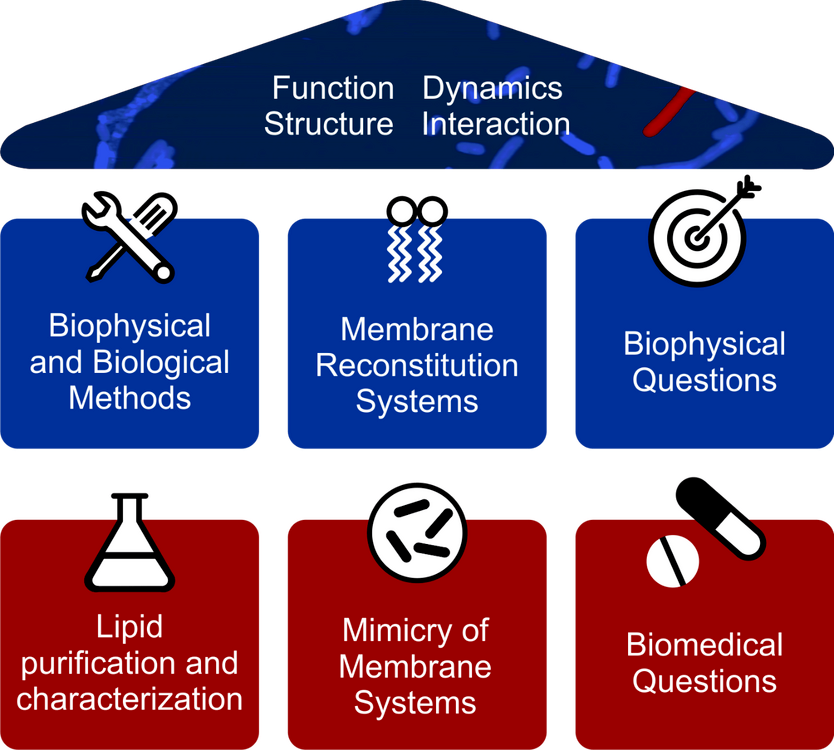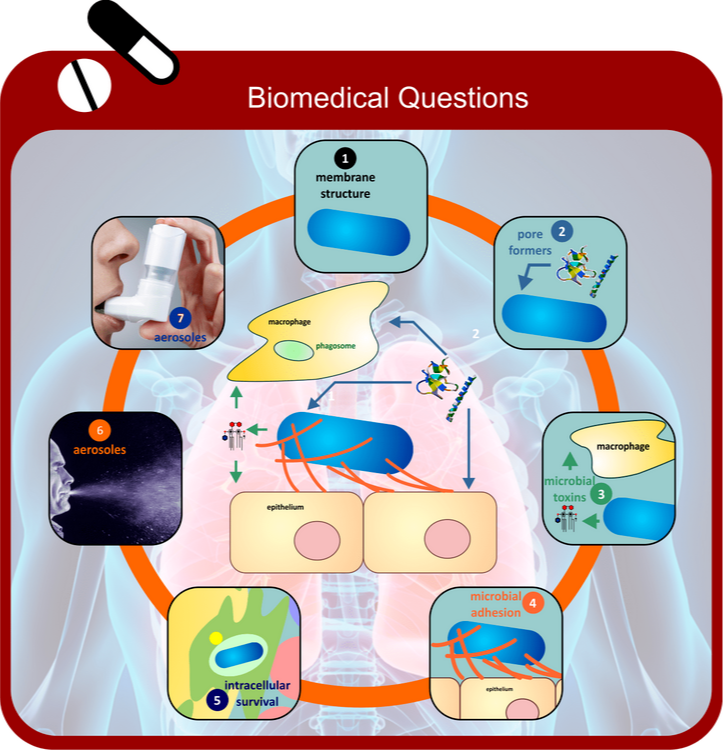Biophysics


The RG Biophysics is dedicated to the structure-function analysis of bacterial and human membranes, their interaction with natural and synthetic antimicrobial peptides and membrane-active substances of pathogens. The focus is on mycobacteria and Gram-negative bacteria. Lung relevant pathogens in particular are characterized by low susceptibility to various AMPs. On the basis of the new findings, the development and characterization of new antimicrobial and anti-septic peptide-based active substances will be advanced up to first clinical trials. The molecular basis of bacterial resistance to natural and synthetic AMPs will be analyzed. This includes both per se existing and induced resistances. The signal transduction mechanisms underlying the activation of human immune cells by bacterial pathogenicity factors and their inhibition by AMPs will be characterized.
A new focus of our work in recent years is the interaction between membrane-active components of pathogens, especially intracellular bacteria, and membranes of human cells. The aim is to elucidate general survival strategies of intracellular microbes and the resulting new therapeutic approaches.
The basis for these investigations are on the one hand the established membrane reconstitution techniques and on the other hand the breadth of existing biophysical measurement methods for the spatially resolved analysis of dynamic processes. In recent years, the use of synchrotron radiation, e.g. at DESY, has been greatly expanded.
The basic philosophy of the Laboratory Group Biophysics is the consistent interdisciplinary connection between biology, chemistry and physics. The focus is on biological questions with medical relevance in pulmonary infections. To answer these questions we have acquired and further developed various biophysical methods. The laboratory group deals with the structure and function of different membranes and their interaction with peptides and proteins. The bacterial membranes of lung-relevant germs have a special focus. The lipids from natural membranes are purified, characterized and then reconstituted in well-defined systems. Whole cells, natural membranes as well as reconstituted membranes are investigated with different biophysical methods (Figure 1).
In addition to the methods available on site, regular measurements are carried out at various synchrotron sources in Germany and Europe.
The following questions are of central importance (Figure 2):
- characterisation of membrane structures
- activity of pore-forming antimicrobial peptides
- activity of microbial toxins
- microbial adhesion
- intracellular survival strategies
- distribution of bacteria by aerosols
- interaction of active substances in aerosols with membranes
Reconstitution Systems
To mimic bacterial and immune cell membranes we established new reconstitution systems. The bilayers were composed of phospholipids, lipid II, and lysyl-PG to mimic the membrane of Gram-positive bacteria, and phospholipids and cholesterol to mimic the cytoplasmic membrane of eukaryotic cells. Furthermore, we reconstituted the outer membrane of Gram-negative bacteria as asymmetric planar lipid bilayer and also as asymmetric liposomes with one side composed of lipopolysaccharides (LPS), the other of phospholipids. In first attempts we have been successful to mimic the mycobacterial wax layer by using lipid matrices containing the glycolipid trehalose dimycolate (TDM).
Function of Antimicrobial Peptides (AMPs)
The AMPs we have investigated within the last years differ in their structure and activity. Starting with our hypothesis that lipid- and peptide-specific properties are responsible for the sensitivity or resistance of certain bacterial strains, we have characterized the interactions between the AMPs and reconstituted lipid membranes. For our investigations we have used various AMPs in their natural form as well as synthetic derivatives thereof. An almost perfect correlation between the biological activity of the AMPs investigated and their interaction with pure lipid matrices has been found. Thus, as a first step, the permeabilization of the lipid membrane is an essential prerequisite for bacterial killing. Based on our findings we were able to synthesize first generation peptides with improved activities. In addition to the pore formation we investigated further mechanisms including membrane fusion or aggregation induced by hydramacin and membrane encapsulation induced by the C-reactive protein from Limulus.
Development of new polypeptides as general microbiocides
We have developed new peptides, which were directed to combat against the Gram-negative sepsis in that the main pathogenicity factor LPS is neutralized by the peptides. Thus, these were called SALP (synthetic anti-LPS peptides). They were shown to effectively block the inflammation reaction in vitro as well as the systemic inflammation in vivo (mouse model of endotoxemia and of infection by bacteria) as well as to inhibit Gram-positive pneumonia in combination with an antibiotic. Additionally, some of the peptides were shown to considerably inhibit virus replication in human cells, such as those of the human immunodeficiency virus (HIV), Herpes simplex viruses I and II, hepatitis B, seasonal influenza H3N2, Dengue fever virus, and classical swine fever virus. The mechanisms of the anti-septic action and of virus replication differ: For the anti-septic activity, a direct binding to the bacterial pathogens take place, but also a binding to cell surface receptors such as CD14 and TLR4.
Survival strategies of intracellular pathogenes
If microbes are ingested by professional phagocytes, different interactions can happen in their phagosomes. These effects can lead to bacterial killing or even to survival of some intra-cellular microbes. There is evidence that on the one hand the phagocyte uses pore-forming peptides of the innate immunity, the so-called host defense peptides (HDP), to kill the microbes, and on the other hand microbes use pore-forming proteins and peptides, for example to prevent acidification of the phagosome. In addition to the elucidation of the underlying mechanisms of action, a central aim is to solve the question of how the microbes and the host protect themselves against the action of their own membrane-active substances. The outer membrane of mycobacteria contains the glycolipid trehalose dimycolate (TDM). The membrane-forming function of TDM and the interaction with different HDPs is characterized.
|
2018-2021 |
LCI Graduiertenprojekt (gemeinsam mit dem BNITM): “Analyses of the binding forces between Plasmodium falciparum infected erythrocytes and various human endothelial receptors” |
|
2018-2019 |
Heidelberger Phospholipidinstitut: „Bottom-up designed synthetic bacteria – a tool to develop new antibiotic strategies“ |
|
2017-2019 |
ZIM Projekt BMWi: “Quantitativer Nachweis matrixassoziierter, antimikrobieller Peptide durch Massenspektrometrie ihrer Aminosäuren” |
|
2007-2018 |
Member and project leader in the Cluster of Excellence „Inflammation at interfaces“. Since 2012 Co-speaker of the Cluster-Lab X “Molecular dynamics”. |
|
2015-2017 |
ZIM Projekt BMWi: “Calciumhaltige Implantatoberfläche mit antibakteriellen, antiinflammatorischen Wirkstoffdepots zur Vermeidung periprothetischer Infektionen” |
- Reconstituted planare membranes
- Atomic force microscopy (AFM)
- Film balance (Langmuir-trough)
- Fluoreszence-Resonance energy-transfer (FRET)-spectroscopy
- Patch-Clamp technique
- Fourier-transform infrared (FTIR)-spectroscopy)
- Surface-Acoustic-Wave Biosensor (SAW)
- Microcalorimetry
- Anibacterial and cytotoxicity tests
- Cell culture systems and cytocine induction (ELISA)
- Dynamic ligth scattering
- zeta-potential measurments
- Synchrotron X-ray diffraction
- Impedance spectroscopy on tethered membranes
2025
Andrä, J, Aisenbrey, C, Sudheendra, US, Prudhon, M, Brezesinski, G, Zschech, C, Willumeit-Römer, R, Leippe, M, Gutsmann, T & Bechinger, B 2025, 'Corrigendum to "Structural analysis of the NK-lysin-derived peptide NK-2 upon interaction with bacterial membrane mimetics consisting of phosphatidylethanolamine and phosphatidylglycerol" [BBA - Biomembranes 1866 (2024) 184267]', BIOCHIMICA ET BIOPHYSICA ACTA-BIOMEMBRANES, S. 184416. https://doi.org/10.1016/j.bbamem.2025.184416
Rossetti, P, Trollmann, MFW, Wichmann, C, Gutsmann, T, Eggeling, C & Böckmann, RA 2025, 'From Membrane Composition to Antimicrobial Strategies: Experimental and Computational Approaches to AMP Design and Selectivity', Small (Weinheim an der Bergstrasse, Germany), S. e2411476. https://doi.org/10.1002/smll.202411476
2024
Allweier, J, Bartels, M, Torabi, H, Tauler, MDPM, Metwally, NG, Roeder, T, Gutsmann, T & Bruchhaus, I 2024, 'Cytoadhesion of Plasmodium falciparum-Infected Red Blood Cells Changes the Expression of Cytokine-, Histone- and Antiviral Protein-Encoding Genes in Brain Endothelial Cells', MOLECULAR MICROBIOLOGY. https://doi.org/10.1111/mmi.15331
Müller, R, König, A, Groth, S, Zarnowski, R, Visser, C, Handrianz, T, Maufrais, C, Krüger, T, Himmel, M & Lee, S et al. 2024, 'Secretion of the fungal toxin candidalysin is dependent on conserved precursor peptide sequences', Nature Microbiology, Jg. 9, Nr. 3, S. 669-683. https://doi.org/10.1038/s41564-024-01606-z
Nehls, C, Schröder, M, Haubenthal, T, Haas, A & Gutsmann, T 2024, 'The mechanistic basis of the membrane-permeabilizing activities of the virulence-associated protein A (VapA) from Rhodococcus equi', MOLECULAR MICROBIOLOGY, Jg. 121, Nr. 3, S. 578-592. https://doi.org/10.1111/mmi.15233
Gutsmann, T 2024, '"Meet the IUPAB councilor"-Thomas Gutsmann', Biophysical reviews, Jg. 16, Nr. 5, S. 515-517. https://doi.org/10.1007/s12551-024-01226-1
Sae-Ueng, U, Bunsuwansakul, C, Showpanish, K, Phironrit, N, Thadajarassiri, J & Nehls, C 2024, 'Nanomechanical resilience and thermal stability of RSJ2 phage', Scientific Reports, Jg. 14, Nr. 1, S. 19389. https://doi.org/10.1038/s41598-024-70056-8
Schaefer, S, Vij, R, Sprague, JL, Austermeier, S, Dinh, H, Judzewitsch, PR, Müller-Loennies, S, Lopes Silva, T, Seemann, E & Qualmann, B et al. 2024, 'A synthetic peptide mimic kills Candida albicans and synergistically prevents infection', Nature communications, Jg. 15, Nr. 1, S. 6818. https://doi.org/10.1038/s41467-024-50491-x
Schromm, AB, Correa, W, Gisch, N, Steiniger, F, Richter, W, Martinez-de-Tejada, G, Brandenburg, K & von Wintzingerode, F 2024, 'Supramolecular assembly of micellar aggregates is the basis of low endotoxin recovery (LER) in a drug formulation that can be resolved by a whole blood assay', Biomedicine & pharmacotherapy, Jg. 173, S. 116286. https://doi.org/10.1016/j.biopha.2024.116286
2023
Andrä, J, Aisenbrey, C, Sudheendra, US, Prudhon, M, Brezesinski, G, Zschech, C, Willumeit-Römer, R, Leippe, M, Gutsmann, T & Bechinger, B 2024, 'Structural analysis of the NK-lysin-derived peptide NK-2 upon interaction with bacterial membrane mimetics consisting of phosphatidylethanolamine and phosphatidylglycerol', BIOCHIMICA ET BIOPHYSICA ACTA-BIOMEMBRANES, Jg. 1866, Nr. 3, S. 184267. https://doi.org/10.1016/j.bbamem.2023.184267
Donoghue, A, Winterhalter, M & Gutsmann, T 2023, 'Influence of Membrane Asymmetry on OmpF Insertion, Orientation and Function', Membranes, Jg. 13, Nr. 5, 517. https://doi.org/10.3390/membranes13050517
2022
Al Nahas, K, Fletcher, M, Hammond, K, Nehls, C, Cama, J, Ryadnov, MG & Keyser, UF 2022, 'Measuring Thousands of Single-Vesicle Leakage Events Reveals the Mode of Action of Antimicrobial Peptides', ANALYTICAL CHEMISTRY , Jg. 94, Nr. 27, S. 9530-9539. https://doi.org/10.1021/acs.analchem.1c03564
Bachmann, A, Metwally, NG, Allweier, J, Cronshagen, J, Del Pilar Martinez Tauler, M, Murk, A, Roth, LK, Torabi, H, Wu, Y, Gutsmann, T & Bruchhaus, I 2022, 'CD36-A Host Receptor Necessary for Malaria Parasites to Establish and Maintain Infection', Microorganisms, Jg. 10, Nr. 12, S. 2356. https://doi.org/10.3390/microorganisms10122356
Blackler, RJ, Müller-Loennies, S, Pokorny-Lehrer, B, Legg, MSG, Brade, L, Brade, H, Kosma, P & Evans, SV 2022, 'Antigen binding by conformational selection in near-germline antibodies', The Journal of biological chemistry, Jg. 298, Nr. 5, S. 101901. https://doi.org/10.1016/j.jbc.2022.101901
Hansen, J, Kolbe, K, König, IR, Scherließ, R, Hellfritzsch, M, Malm, S, Müller-Loennies, S, Zallet, J, Hillemann, D, Wiesmüller, K-H, Herzmann, C, Brandenburg, J & Reiling, N 2022, 'Lipobiotin-capture magnetic bead assay for isolation, enrichment and detection of Mycobacterium tuberculosis from saliva', PLOS ONE, Jg. 17, Nr. 7, S. e0265554. https://doi.org/10.1371/journal.pone.0265554
Lagune, M, Le Moigne, V, Johansen, MD, Vásquez Sotomayor, F, Daher, W, Petit, C, Cosentino, G, Paulowski, L, Gutsmann, T, Wilmanns, M, Maurer, FP, Herrmann, J-L, Girard-Misguich, F & Kremer, L 2022, 'The ESX-4 substrates, EsxU and EsxT, modulate Mycobacterium abscessus fitness', PLOS PATHOGENS, Jg. 18, Nr. 8, S. e1010771. https://doi.org/10.1371/journal.ppat.1010771
Mogavero, S, Höfs, S, Lauer, AN, Müller, R, Brunke, S, Allert, S, Gerwien, F, Groth, S, Dolk, E, Wilson, D, Gutsmann, T & Hube, B 2022, 'Candidalysin Is the Hemolytic Factor of Candida albicans', Toxins, Jg. 14, Nr. 12, 874. https://doi.org/10.3390/toxins14120874
Möller, C, Heinbockel, L, Garidel, P, Gutsmann, T, Mauss, K, Weindl, G, Fukuoka, S, Loser, D, Danker, T & Brandenburg, K 2022, 'Toxicological and Safety Pharmacological Profiling of the Anti-Infective and Anti-Inflammatory Peptide Pep19-2.5', Microorganisms, Jg. 10, Nr. 12, S. 2412. https://doi.org/10.3390/microorganisms10122412
Palusińska-Szysz, M, Jurak, M, Gisch, N, Waldow, F, Zehethofer, N, Nehls, C, Schwudke, D, Koper, P & Mazur, A 2022, 'The human LL-37 peptide exerts antimicrobial activity against Legionella micdadei interacting with membrane phospholipids', BIOCHIMICA ET BIOPHYSICA ACTA-MOLECULAR AND CELL BIOLOGY OF LIPIDS, Jg. 1867, Nr. 6, S. 159138. https://doi.org/10.1016/j.bbalip.2022.159138
Roeckendorf, N, Nehls, C & Gutsmann, T 2022, 'Design of Membrane Active Peptides Considering Multi-Objective Optimization for Biomedical Application', Membranes, Jg. 12, Nr. 2, 12020180. https://doi.org/10.3390/membranes12020180
Head

Scientific staff







Technical staff



